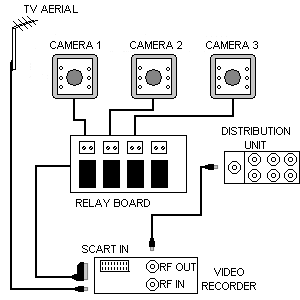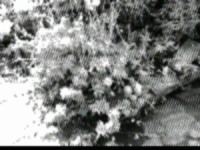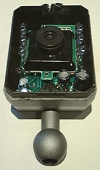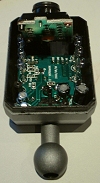HOME SECURITY CAMERAS
Cameras
With the decrease in price of CCTV cameras, and the improvement in quality (apart for the cheapest cameras), setting up a CCTV camera system to augment a security system has become far more viable in the last few years. The additional steps required to connect CCTV camera outputs to a PC as well as videos / TVs are little more taxing than hooking up an RF lead to the RF-in socket on a PC TV card. From this point, it then becomes little more effort to install software on a PC to enable it to post images from a CCTV camera onto a website.
The cameras in the setup I have used, are wired up to a commercial relay board which I acquired as an add on to the security system. The relay board can be controlled either via the security system, or by computer. The output from the relay board is connected to a SCART socket which is then plugged into a SCART socket on a video recorder. A feed from the aerial is also fed to the video recorder. The UHF out socket is then wired to a UHF distribution unit which distributes video/TV/CCTV signals via co-ax to UHF sockets in the rooms. This allows videos or DVDs to be viewed on any TV in the house.
A feed is also taken from the distribution unit and is connected to the RF in socket on a Hauppage Win-TV PCI card in the home automation server, where motion software is used to detect any motion between frames, and taking appropriate action.
The 3 principal external cameras are the Front Door Cam, the Cat Cam and the Garden Cam. There are other concealed cameras, but for obvious reasons, only the 3 above are listed.

Front Door Cam

Figure 1: Front Door Camera
The Front Door Cam is a 380 line Colour Bullet CCD video camera from RF Concepts, designed to allow viewing of anyone who comes to the front door before opening the front door. The camera is slightly sheltered from the worst of the elements by being under the front door porch, and even without an external housing, seems to be weatherproof (or has proved to be in over a year of operations so far, anyway!)
The image shown here is from the previous Black and White door cam, which was lousy. This image was captured during set up, with the camera input connected to the RF-Input of the PC TV card. Clearly, a bit of adjustment was needed to see things other than the bush, but even then, the field of view is just too small to really be of any use.
Cat Cam
The Cat Cam is a Black and White CCD video camera, making use of a low light Black and White unit as opposed to the low cost Black and White CCD unit I used previously. Given the cat's spectacularly bad time keeping, it allows a watch to be posted at the back door via camera, so if the cat rolls up late, it is possible to check to see if the cat is waiting to come in. This works surprisingly well.
Garden Cam
The Garden Cam is another Black and White CCD video camera (again, a low light unit), and is like watching a nature programme on the TV, only from the garden..
CAMERA CHOICE

Figure 2: The cheap and lousy option
Originally, I bought some cheap Black and White CCTV cameras from a large DIY store. This was not the best move. The quality was lousy (384 x 287 with bad low light performance aswell), the viewing angle was lousy, and the cable seemed to be pretty lousy. Cheap CCTV cameras generally use cheaper CMOS image sensors as opposed to the more expensive CCD image sensors. The problem with this, is that from my experience, CMOS sensors don't seem to cope with low light levels so well, so as soon as the light fades, the chance of getting an image fades too.

Figure 3: The cheap and lousy option
The cheap camera units I originally used, have 6, 3mm diameter, Infra-Red LEDs for improved low light vision, and are supposed to be able to image down to a light level of about 0.1 lux, although I wouldn't bet on it. If they work at 0.1 lux, then from what I saw of them after I installed them, it is either a different definition of lux to the one I had heard of, or they work only at very short distances. Sufficiently short distances that I felt the need for a large IR illuminator. The performance in anything less than dusk is as good as non-existent.
I decided it would be better to fit some high resolution CCTV camera units. The problem was, there were few of really decent resolution, and those that were, tended to be very expensive. I looked at units from Henrys, Maplin, RS, Farnell, and eventually settled on some decent quality CCTV bullet cameras at RF Concepts, and discovered just how much difference good optics makes to the resultant image. Not only is the image quality of the new bullet cameras far, far better, but it is in colour, produces a colour image at much lower light levels than the cheap black and white cameras I used before, and at really low light levels, it switches to Black and White - clever.
I have now also acquired a 480 line, low light capable, CCD Colour Bullet Cam from RF Concepts. The quality is, unsurprisingly, even better than my other CCTV cameras. If you can afford the extra cost, then it is well worth buying these cameras for security purposes. The improvement in resolution means far more ability to identify details of potential intruders.
CONCLUSIONS
- Don't scrimp on getting a decent quality CCTV camera - it's a false economy if the image quality is so bad, that you can't actually identify objects accurately. Remember, the point of a security camera is to be able to identify objects or people. If you buy a security camera where the quality is so poor that identifying anything is very difficult, then you are being lulled into a false sense of security.
- For an extra few pounds (or few tens of pounds if you get a whole reel), do get some decent quality, shielded cable to connect a CCTV camera to a TV / video / PC / relay board. It can make an enormous difference in terms of quality of the final image, since the cable is then less susceptible to interference. Cheap, thin cable as generally supplied with CCTV can get swamped and result in noisy, poor quality images (been there, torn my hair out, had to fix it). Any half decent cable designed for video is normally better than the cable supplied with CCTV cameras. Ideally, try and use a cable such as CT100 or even CT125. This cable is more expensive, but the attenuation losses are far less.
- Again, for a relatively small outlay, try and use decent quality connectors (BNC rather than phono, for instance). All the little touches add up in terms of improved quality of the signal, or increased robustness of the system.
- The choice of Colour or Black and White CCTV cameras comes down to what features you would prefer. Colour has a big advantage in that you can identify objects of interest with a better degree of accuracy. Black and White generally works at much lower light levels. Some CCTV cameras offer the capability to switch from Colour to Black and White at certain light levels, which is very useful.
- The Colour Bullet Cameras from RF Concepts are excellent security cameras. Out of the 3 types of CMOS Black and White Cameras, 1 type of CCD Black and White Camera, 2 types of CMOS Colour Cameras and 3 types of CCD Colour Cameras I have used for both security and rocketry applications, the RF Concepts Colour CCD Bullet Cameras are without a doubt, the best, especially the 480 TV line and 550 TV line versions.
CCTV CAMERA SOURCES
CCTV CAMERA PC SOFTWARE
- www.gotcha.com - Windows based motion detection software
- www.homewatcher.com - Windows based motion detection software

